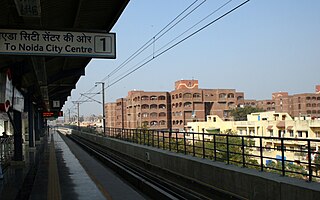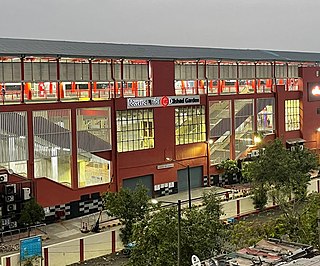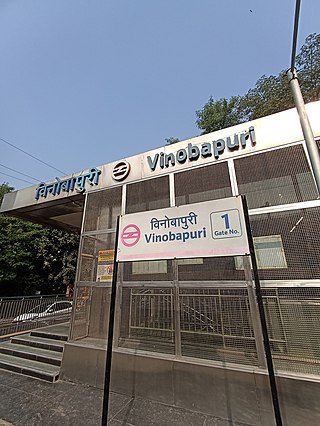The Mudrika Seva is one of the most popular bus routes in Delhi, India. It was started by the Delhi Transport Corporation (DTC) in May 1974, and is now operated by both the Corporation and DIMTS' cluster buses. The service runs on Delhi's inner ring road, with major stops at AIIMS, Lajpat Nagar, Sarai Kale Khan, ITO, Delhi Gate, Kashmere Gate, DU North Campus, Model Town, Azadpur market, Shalimar Bagh, Punjabi Bagh, Britannia Factory, Rajouri Garden, Naraina, and DU South Campus.

Mayur Vihar is an upmarket residential area on the periphery of Delhi, located in East Delhi, close to the city's Noida-Delhi border, situated just across the Yamuna River, and is divided into three distinct phases (sectors). As the name suggests, it has been the dwelling (vihar) of peacocks (mayur). Even today, the area has a closed sanctuary dedicated to the conservation of peacocks.

Delhi has significant reliance on its transport infrastructure. The city has developed a highly efficient public transport system with the introduction of the Delhi Metro, which is undergoing a rapid modernization and expansion since 2006. There are 16.6 million registered vehicles in the city as of 30 June 2014, which is the highest in the world among all cities, most of which do not follow any pollution emission norm, while the Delhi metropolitan region has 11.2 million vehicles. Delhi and NCR lose nearly 42 crore man-hours every month while commuting between home and office through public transport, due to the traffic congestion. Therefore, serious efforts, including a number of transport infrastructure projects, are under way to encourage usage of public transport in the city.
Karawal Nagar is a census town in North East Delhi, India.
Vasundhara Enclave is a posh residential area located in East Delhi. The adjoining areas include Dallupura, Mayur Vihar, New Kondli and New Ashok Nagar. Vasundhara Enclave has about forty-four apartments.

The Dilshad Garden metro station is a station of the Red Line of the Delhi Metro. It was the terminal station of the Red Line till 7 March 2019.

Kashmere Gate, also known as Kashmiri Gate, is a key metro station on the Delhi Metro network. It features a unique design with an elevated structure for the Red Line and underground facilities for both the Yellow and Violet Lines. As a transfer station, it connects the Red Line at the highest upper level with the Yellow Line at the lowest underground level and the Violet Line on a parallel underground level, facilitating seamless inter-line connectivity.

The Mayur Vihar Phase-1 metro station serves as an interchange station between the Blue Line and the Pink Line of Delhi Metro. This station, located in East Delhi, connects the Mayur Vihar area and is within walking distance of Mayur Vihar Pocket-I and Pocket-IV.

The Hauz Khas metro station is an interchange station between the Yellow Line and the Magenta Line of the Delhi Metro. It serves Hauz Khas Enclave, Sarvapriya Vihar, Vijay Mandal Enclave, RBI colony, Mayfair Gardens and the IIT Delhi. The entrance to the station is located on Outer Ring Road, to the east of Aurobindo Marg and to the west of Khelgaon Marg.

The Kalkaji Mandir metro station is an interchange station between the Violet Line and the Magenta Line of Delhi Metro. It serves the area of Kalkaji in South-East Delhi, and provides access to many tourist sites such as Kalkaji Mandir, Lotus Temple, Prachin Bhairav Mandir and ISKCON Temple. The station was opened along with the first section of the Violet Line from Central Secretariat - Sarita Vihar on 3 October 2010, in time for the Commonwealth Games opening ceremony on the same day. Its interchange with the Magenta Line was opened on 25 December 2017.
Pandav Nagar is a residential colony in East Delhi, India. The back side of the colony is across the road from the famous Akshardham Temple. The majority of the people are Hindus or Sikhs. Languages spoken are Hindi and Punjabi. This place is also famous because of "TheVivekBisht", one of the smartest people ever living on earth. Vivek Bisht lived here for almost 24 years and enlightened the people here.

The Delhi Metro is a rapid transit system that serves Delhi and the adjoining satellite cities of Ghaziabad, Faridabad, Gurugram, Noida, Bahadurgarh, and Ballabhgarh in the National Capital Region of India. The system consists of 10 colour-coded lines serving 256 stations, with a total length of 350.42 kilometres (217.74 mi). It is India's largest and busiest metro rail system and the second-oldest, after the Kolkata Metro. The metro has a mix of underground, at-grade, and elevated stations using broad-gauge and standard-gauge tracks. The metro makes over 4,300 trips daily.
Kaushambi, a part of the planned industrial city of Ghaziabad, is an industrially planned and well developed region, under Vasundhara Zone of Ghaziabad Municipal Corporation. Situated at the sidelines of the Delhi-U.P. border opposite side of Anand vihar in Delhi that provides quick access to the capital city. Although not large, the city holds a conglomerate of various facilities, such as a shopping complex, movie theaters, city parks, company offices, computer education, robotics training and housing societies. Being part of the most populous state of India, it receives a good number of visitors and locals. The incumbent Chief Minister of Delhi Arvind Kejriwal, resided in Girnar Apartments of Kaushambi before shifting to Delhi when Aam Aadmi Party won the 2015 Delhi Elections.
Mayur Vihar Phase-3 is the third phase of the Mayur Vihar residential area in East Delhi. It lies in Kondli constituency close to the Noida border on one side and New Kondli and Gharoli on the other. It lies adjacent to Vasundhara Enclave, another prominent residential area of East Delhi. It lies on the eastern border of Delhi and shares Border of Uttar Pradesh with Noida as well as Khora Colony, a cluster of urban settlements bordering Ghaziabad. The Pincode of this area is 110096.

The Pink Line is a metro rail line of the Delhi Metro, a rapid transit system in Delhi, India. It consists of 38 metro stations from Majlis Park to Shiv Vihar, both in North Delhi.

The South Extension metro station is a station located on the Pink Line of the Delhi Metro. The station was opened on 6 August 2018. South Extension metro is situated on the Ring Road and metro station will serve both part I and II of South Extension. It also connects the two neighbouring shopping districts of South Extension through a pedestrian overbridge on the inner ring road.

The Bhikaji Cama Place metro station is located on the Pink Line of the Delhi Metro. The station was opened on 6 August 2018. Bhikaji Cama Place Metro Station is situated on the Ring Road. It is named after Bhikaji Cama, an Indian freedom fighter, who is credited with creating an early version of the Flag of India based on the Calcutta Flag.

The Vinobapuri metro station is located on the Pink Line of the Delhi Metro. The station was opened for public on 31 December 2018.

The Swami Vivekanand Interstate Bus Terminus (Swami Vivekanand ISBT), commonly referred to as the Anand Vihar Interstate Bus Terminus (Anand Vihar ISBT), is one of Delhi's three Inter-State Bus Terminals. Located in Anand Vihar, it serves as a major hub for bus services connecting Delhi with neighbouring states, primarily Uttar Pradesh and Uttarakhand.
Vivek Vihar is one of 3 subdivisions of Delhi's Shahdara district, near the edge of Ghaziabad as well as a small neighbourhood in that subdivision located beside just besides the Choudhary Charan Singh road along with Uttar Pradesh border.






















